Every once in awhile, a question makes it to my inbox that's too good to ignore.
A friend and I were joking about being "older than dirt" and he asked a question I thought you might enjoy: "Hey, ask Ethan how old dirt is and how it got here."
You did the smart thing by coming to me, because the alternative is to ask yahoo. (Shudder!) Well, right away, we've got an upper limit, because the entire Solar System is only about 4.5 billion years old. So, there's no way that this:

is any older than this:
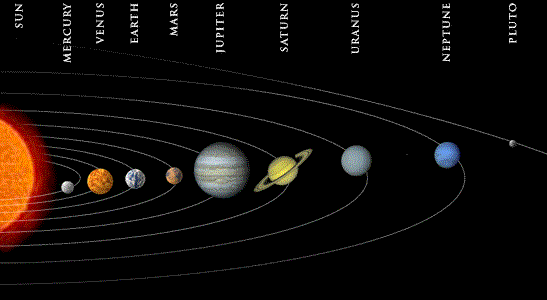
Now, you can definitely go looking for the oldest rocks on Earth, and if you look very hard, you'll find rocks that are 4.4 billion years old, or nearly as old as the Earth itself!
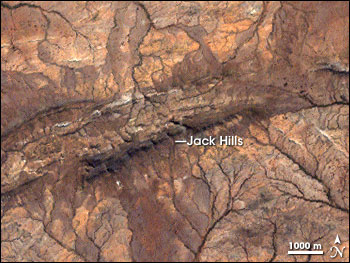
These rocks come courtesy of the Jack Hills in Western Australia. But, that's rock, not the dirt you're used to seeing. Because the Earth is an active planet, with oceans, rains, winds, and mobile tectonic plates, what we commonly know as "dirt" gets recycled over and over again.
How does that work? Well, let's go through a brief version of the history of dirt on Earth. The interior of the Earth is molten, and this heat comes up from somewhere. Right now, the sea floor is spreading in the middle of the Atlantic Ocean:
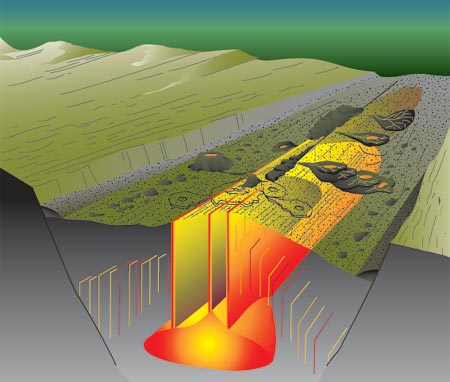
This causes the plates to spread away from the ridge. As these plates tend to move around, two of them will, at some point, collide together. What happens when we get a collision of plates? We form mountain ranges!
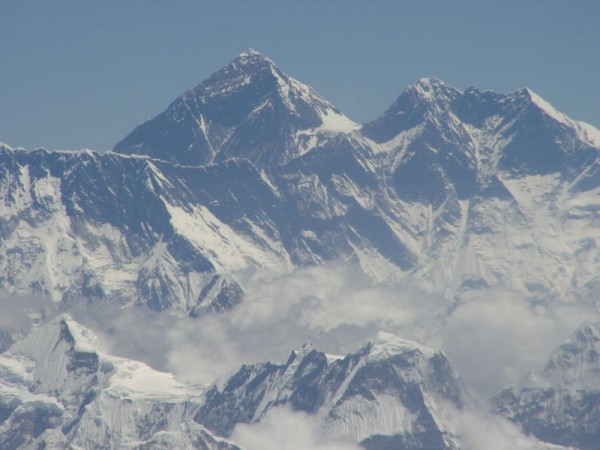
These are the Himalayas, not only the tallest mountain range in the world, but also one of the youngest mountain ranges in the world. Compare this to the Appalachian mountain range, which is less than one-quarter of the height of the Himalayas, but which is the oldest mountain range in the world, with parts dating back as far as 480 million years!

Well, even 480 million years ago, the world was teeming with plants, animals, bacteria, rain, winds, and lots of other things that erode rock and produce dirt. But, this dirt, especially sand and topsoil, is subject to the most relentless force of all on Earth: gravity. Over time, this dirt finds its way --one way or another -- to the lowest elevation possible, which is to say, the bottom of the ocean.

So, although rocks may be over 4 billion years old, dirt isn't. In fact, after the end of the last ice age (around 12,000 years ago), glaciers moved much of the topsoil around North America, leaving many regions scarred and soil-less. And yet, plants, wind, rain, ice, animals, and other factors immediately began creating soil again. While there is most definitely "old" dirt that is many tens of thousands of years old, most of the dirt that's out there, as best as I've been able to find, is just a few thousand years old. Or, you know, as old as some of the oldest trees we have:
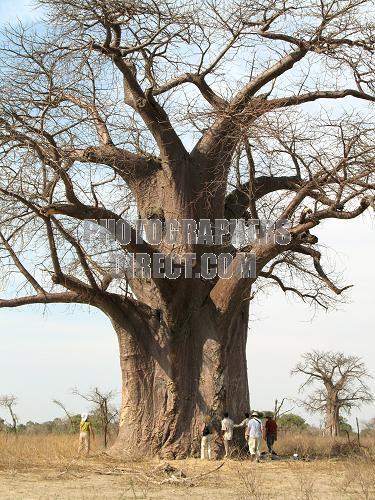
So, the next time someone tells you you're older than dirt, you'll be able to smile to yourself, knowing that dirt on Earth isn't nearly as old as they think it is. It's just rock that's been reduced to a dusty pulp over the last few thousand years. Not so old, at least, geologically speaking.

That is, until someone tells you that you're older than Moon dirt. That is billions of years old, and that's old any way you slice it. So watch out; those are fightin' words.

I like your sense of humor :)
With all this subduction of (mainly sea floor)land beneath continental plates is there any evidence that continental land mass has also disappeared in the same way? The old pictures of Gondwanaland, Pangea etc are usually shown to be composed of the current continents, simply in a different position prior to their continental drift. Was there other lands, even continents, existing in ancient times that have gone the way of the pacific sea floor?
I like your summary--but feel obligated to point out that Earth's interior isn't, in fact, molten. (Well, except for the outer core. But that's molten metal, not molten rock.) There are very small regions of magma in some areas (e.g., beneath some mid-ocean ridges), but the mantle is, by and large, solid. (If it were liquid, the S-waves from earthquakes wouldn't be able to travel through it, just as they aren't able to travel through the outer core.) Sorry if that seems nitpicky, but it's one of my pet misconceptions :)
Sigmund, the short answer to your question is yes, there is evidence that some continental rock has been subducted. (Actually, every subducting oceanic plate contains sediment that came--at least in part--from the continents, so in that sense, continental material subducts all the time.) Bulk continents are substantially less dense than sea floor, so they don't subduct easily; but small amounts of continental rock can and do subduct. The main evidence for that (as far as I know) comes from geochemistry--continental rocks have different compositions from oceanic rocks, so the subduction of continental material can influence mantle geochemistry.
On the whole, though, the general consensus is that the continents have generally been growing larger over time, and that they generally have not been significantly subducted.
Surely some tiny fraction of the Earth's dirt must be extra-terrestrial in origin, though? (Fragments of impacting or air-bursting meteors.) So the question is whether someone is older than generic dirt - a few thousand years - or older than the very oldest dirt, which is potentially older than the solar system, but incredibly rare and hard to find :)
Just to be picky and rattle Prof. Siegels' cage a little, Mount Everest is the tallest mountain in the world in terms of elevation above sea level. I believe that Mauna Loa in Hawaii is the tallest mountain in the word as measured from its base
Question on the really old Jack Hills, is that rock that was actually exposed for 4.4 billion years, or is it stuff that was covered for most of its existence and just happen to end up on the surface again now?
Re: the Appalachians being the oldest, I thought the Ozarks are the oldest range. Given that we have no idea what lies underneath the Antarctic continent, that may be where oldest of old exists.
As a geographer I always delight in telling students that the worst soil lies in the rainforests and tropical zones and that the plains and savanna have the deepest "A" horizon. It never fails to surprise them. They assume the lush canopy means rich soil but that simply is not true.
The above analysis is fine for any given sample of dirt, but when I hear the phrase "older than dirt", I usually interpret this to mean "older than before dirt itself existed". So my question is, when did dirt first come about? Does dirt of any kind go back to the first rocks? Of course when most people say "dirt" they usually really mean "soil", and I suppose soil didn't exist before plants.
"older than dirt" means about 6000 years ago; god created light and darkness and heaven and earth (no mention of hell though), but he hadn't created the garden of eden yet; no eden obviously means no dirt yet.
You can see dirt in the making if you visit places like Sicily (Mt. Etna) and Hawaii. You can see plants breaking up the glassy rock flows and you can find dirt in pretty much all phases of its development. If you're in Hawaii, stuff yourself with macadamia nuts, and if you're in Sicily you've got the world famous Bronte pistacchios (well, they're world famous in Sicily).
I love dirt, no matter how old it is!!
Sigmund, the reason that it looks that way is because continental plates are a lot less dense and several times thicker than oceanic plates. It then becomes of matter of buoyancy thus when two continental plates collide you get mountain ranges (eg: the Alp and Himalayas).
But how do you define the age of a piece of dirt? Most of what you're describing is just moving it around.
The hydrogen atoms in your bloodstream are nearly as old as the universe (and the energy bound up in their mass is as old); the oxygen atoms, not so much.
This is interesting, I just had a soil science course last semester. Soil, or dirt if you prefer, actually varies quite a lot in age. There is even a taxonomic classification system for soil of different ages with different properties. Soil can be very young or very old, from topsoil of a few decades to ancient tropical soils of greater than 100,000 years.
It is quite possible to be older than dirt! But very little dirt is younger than the oldest living person.
Some info on soil orders:
http://soils.ag.uidaho.edu/soilorders/orders.htm
Soil science is a pretty interesting subject btw, highly recommended.
My flowerbeds are about 50% compost, which I started making 18 months ago out of other things. Is that dirt? Or soil? Or would it be classified as just compost?
I wonder how old the dirt in my belly button is------?
All dirt began as droppings - even if just things dropping dead, beginning with the first planty things that emerged from life clinging to the above-water rockmasses.
So, Celania - your compost is dirt. Also soil; there's not really much distinction other than nuance. Could be "turf"; could be "soil." That's why the English language has so many words in the dictionary to choose from - nuance.
I could go on - I'll spare ya.
Of course if you soil yourself, that's pretty new soil.
I was trying to answer two questions and found you site I found it to be most interesting and I will return to learn more at a later date. However, the two questions I have been trying to answer (am not finding much I might add) are as follows:
1) Why are the geology and topography of the sea floor simpler that that of the continents?
2) Why is the maximum age of rocks on the sea floor so different from the age of the oldest rocks on the continents?
If you have any suggestions I would be very interested I will spread the word about this site too it is just amazing!!!
Thank you
Cindy
You throw around numbers of years, and dates. But what is your proof that they are actually that old?
i want to know how old is dirt becuase my teacher said she is 8 years older than dirt
Careful! Don't let a soil scientist hear you call it dirt!!